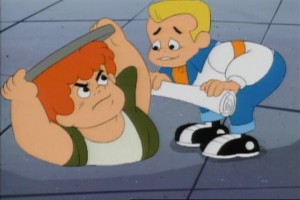Today’s Old School Wednesday Review is from Jeremy.
Jeremy Rodden is a stay-at-home dad and author of the Toonopolis Files series of cartoon novels. He considers C.S. Lewis and Lewis Carroll his biggest influences as a writer and hopes to create a lasting, fun world that all ages can enjoy. You can follow him on Twitter (@toonopolis), Facebook (www.facebook.com/toonopolisfiles), or his cartoon review/author blog (www.toonopolis.com).
* * * * * * * * * * * * *
Many people of my generation think of the early 90’s as a golden era of cartoons, with shows like Tiny Toon Adventures and Animaniacs (not to mention its spinoff, Pinky & the Brain). What people liked about these shows was that they were filled with parody, fourth-wall breaking, and irreverent humor. Many people forget that it wasn’t Tiny Toons that started this trend and many others don’t realize that the same producer, Tom Ruegger, was responsible for all of these shows (including later shows like Freakazoid and Histeria!). The trend-setting cartoon I am talking about here is A Pup Named Scooby-Doo.
Borrowing from the concept of taking existing characters and making them younger (popularized a few years earlier in Jim Hensen’s Muppet Babies), A Pup Named Scooby-Doo made Scoob and the gang younger (around 12-13 or so) and their first iteration of Mystery Incorporated known then as the “Scooby-Doo Detective Agency.”
The show was insanely formulaic and had a ton of self-referential humor, mocking the same formulaic nature of the previous versions of Scooby-Doo. In every episode, we get the mystery, the clue-searching, the obligatory musical chase scene (probably the best part of every episode), the Shaggy/Scooby disguise bit to trick the monster, Freddy blaming the aptly named Red Herring for every crime (except the one time it was ACTUALLY Red who was the bad guy), and the final reveal with the “pesky kids” epithet replacing “meddling kids.”
A Pup Named Scooby-Doo was such a great example of how a formula show can be successful every episode. Since it was a parody, the writers were able to go over-the-top with every episode without restricting themselves to concepts of realism that sometimes made the other Scooby-Doo shows hard to swallow (not that it ever stopped any of the previous writers from somehow giving every villain the advanced animatronics, holograms, or puppetry skills to create insanely unrealistic monsters, ghosts, and other baddies).
In this show, a Scooby Snack wasn’t just a treat, it was a tool that gave Scooby magical powers (such as flight or turning into a rocket). Velma’s magical briefcase could turn into any type of computer or analytic equipment she needed. Daphne’s butler, Jenkins, could turn up at any moment for her dumbest whim. All of the characters are pretty two-dimensional and slapsticky, but that was what made the show so great. I’ve learned from my own experience (writing my Toonopolis books) that conventional rules of character development can get thrown out the window when you work with parody as a medium.
The show was fun, had catchy chase songs (they even put out a CD of them!) unique to each episode, and established an entire genre of self-referential cartoon parodies that led to such great works as the aforementioned Animaniacs. I strongly consider A Pup Named Scooby-Doo one of the earliest influences of what would later become Toonopolis as well as an important landmark show that proves parody work can be successful. While Tiny Toons and Animaniacs would be far more popular shows, the groundwork was laid here. If you’ve never seen it, you need to treat yourself to it. If you have seen it, watch it again… it’s still just as great.












3 comments
1 ping
I used to eat this show up when I was a kid. =)
Loved this show when I was a child 🙂
Thank you, this brings back hilarious memories.
I Love this show! They need to re-air it on Cartoon Network
[…] Credit: Toonopolis. […]